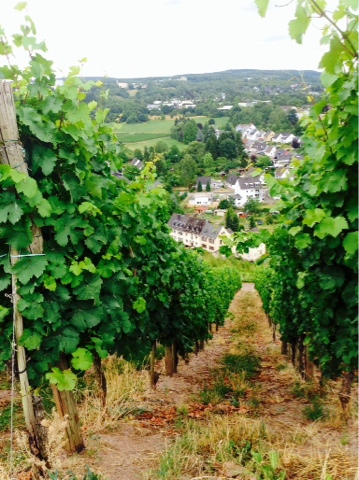Our first stop into Germany was at a town called Aarchen, or as we affectionately named it, "arrrrg". We stopped here for two reasons, an impressive cathedral and a speciality food. The cathedral proved to be closed for renovations disappointingly. Have a picture of squeezed fish instead.
The speciality food did not disappoint. A type of gingerbread biscuit called Printen, we found a bakery off the square selling bags of the stuff.
Printen it turned out, originally probably came from Dinant in Belgium, and it wasn't until copper producing craftsmen came to Aarchen in the 15th century (bringing their recipe with them) that it became a speciality here. Funnily enough due to the honey and various spices these biscuits contained, they were originally sold at pharmacies for medical properties. Nowadays you can choose from original, chocolate and nut, or a faintly aniseed glaze. All are very nice (we bought a mixed packet so as to try all the flavours. Greedy? Never!) but original was my favourite.
Our next stop was to pass through Cologne for its colossal Cathedral: the biggest Gothic Cathedral in Northern Europe in fact. Named Germany's most visited landmark with 20,000 people a day coming to see it, it dwarfed the crowds below. Work on this monolith began in 1248, but stopped in 1473 and it wasn't completed until 1880. In the 1100s important artefacts such as relics of the Three Kings (who followed the star to see baby Jesus) were brought to Cologne, creating a demand for a suitable area to house such artefacts. Thus the cathedral plans began.
During World War II, this magnificent cathedral suffered fourteen hits from allied bombing and was badly damaged. Even so, it remained standing in an otherwise completely flattened city.
After our brief jaunt around Cologne, we headed for a site far older. Trier was home to a number of Roman sites, and as such had piqued our interest. The Porta Nigra arrested our eyes as soon as we entered the town. Looming and bleak in the rain, it looked like something out of Lord of the Rings (and indeed I couldn't stop myself whispering a number of times "the Black Gate of Mordor!!" in what I hoped was a passable Gollum impression)
Serving as an entrance to the town, the Porta Nigra was built between 186 and 200 AD. For reasons unknown, it was never finished, but formed an impressive gate nonetheless. Unlike many of the other gates of this city that were slowly torn down for building materials after the end of the Roman era, this gate was turned into a church in the 11th century thus keeping it preserved. Additions were made to turn this structure into a working church, but in 1804 Napoleon ordered the gate to be returned to its orginal Roman state and the church was dissolved. Thus the gate as we see it today is unchanged since Napoleans reconstruction.
As always when wandering Europe, it was possible to see these little signs engraved on the ground outside houses, marking the last living place of the Jews who were deported and murdered during the Holocaust.
My favourite Roman site in Trier turned out to be the Roman Baths. Surprisingly cheap at 3 euro per person, this structure would have once been monumental - the largest bath complex this side of the Alps in fact. Beneath the innocent facade of grass lay a network of impressive and winding tunnels that were just eerie enough to be exciting without being claustrophobic.
Built by Emperor Constantius I beginning sometime before 300, they were never completed. However they were reused in as a barracks and then later, a Medieval castle.
Tired out from our historical meanderings, we decided to take a lunch break before continuing. We came across a restaurant serving recipes from the famous chef Marcus Gavius Apicius who cooked for the Roman emperor Tiberius. Unfortunately we couldn't get the mains as they were a dinner only special, but we decided to try some interesting sounding entrees and drinks. Yannick chose some rather delicous herby sausages, and Necia and I picked the barley and pork soup. Unfortunately it wasn't anything special, although it was interesting to try Barley, and it had a nice thick texture, the pork made me afraid it had come from a can (and there was an awful moment where I felt quite sure it was actually tinned tuna) and the soup itself was strangely enough, overly sweet. The Roman drink was rather nice however, consisting of honey and wine and strong herbs it was unlike anything I had tried before. Feeling somewhat hungry still, we topped ourselves up with a chocolate twist from a nearby bakery.
We stopped for a quick look at the Roman arena, but it was in fact rather disappointing. The seats were long gone (although the grass was still shaped as if the seats could be resting underneath strangely enough) and there was little to see. A mock sword fight between 'Romans' did little to improve the site.
Feeling not quite replete still, we decided to get wifi and a Dame Blanche at a nearby restaurant. There were some amusing comic icons that we passed both on the street and in the restaurant.
To end our day and work of our double dessert lunch, we headed up to the hills for a stroll among vineyards and a view of the town.














No comments:
Post a Comment